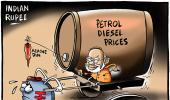Some of the proposals (for example trade margin calculation for imported medical devices) were not approved by the PMO and were sent back for revisions.

The Central government is planning to make major changes in the Drug Price Control Order (DPCO) 2013 and come out with a new policy soon.
However, the draft that was presented before the Prime Minister's Office (PMO) has been sent back for reworking, sources said.
It is learnt that in a meeting at the PMO sometime back, the draft was presented before the Prime Minister himself.
The meeting was attended by officials from the NITI Aayog, Department of Pharmaceuticals, and National Pharmaceutical Pricing Authority (NPPA).
Some of the proposals (for example trade margin calculation for imported medical devices) were not approved by the PMO and were sent back for revisions.
"The government is trying to bring down prices of commonly used medical devices and drugs.
"It, thus, wants to have a policy in place that will not only help to roll out Modicare (the government's ambitious national health insurance scheme), but also ensure it is people friendly in the sense that it makes drugs and devices affordable," said a source close to the development.
The new policy was expected to see the light of the day around July-August.
Sources indicate it might now take much longer, as 2019 is an election year and the government would tread carefully.
One of the proposals, it is learnt, was that trade margins on medical devices be calculated on the first point of sale.
This included imported medical devices. The importers' lobby had reasoned with the policymakers that they incur several costs while importing and, hence, the trade margins be calculated on the first point of sale, which is the stockist.
Domestic device makers, however, say this would not help bring down the prices of devices, and, as such, around 70-80 per of the medical devices used in the Indian market are imported.
Therefore, it is being deliberated whether trade margins should be calculated on the landed cost of the device.
The maximum retail price (MRP) would be calculated by adding trade margin to either the landed cost or the price at first point of sale.
"In case it is calculated on the basis of the price on the first point of sale, the MRP would be higher. There is some difference between the senior officials on this point," the source said.
If prices of medical devices are calculated based on trade margin rationalisation, then, effectively, it would come out of the purview of the DPCO, and the NPPA, which is responsible for implementing the DPCO. A decision on the same is yet to be taken.
At present, cardiac stents, intrauterine devices, condoms and knee implants have been brought under price control under the DPCO 2013.
Another suggestion from the PMO is on using QR codes for blisters and packs of pharma packaging to effectively track movement of drugs (so as to check the menace of counterfeit) and to give immediate benefits of price revision to consumers.
Once the price factor is included in the QR code, the change could be implemented for existing batches in the market and one can also monitor if the price change has been implemented appropriately.
"The government wants the benefits of the price reduction (whenever that happens for drugs under price control), to reach the consumer immediately," the source said.
| Back to the drawing board |
|
Photograph: Lucas Jackson/Reuters











